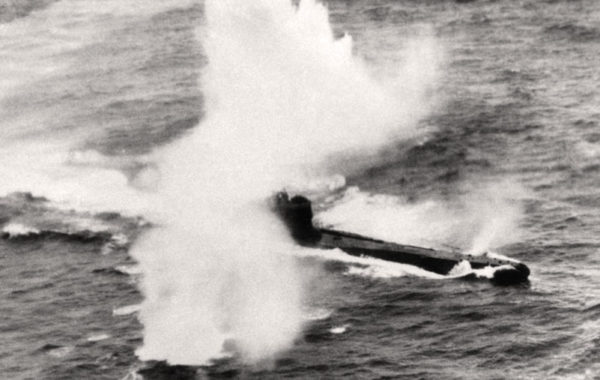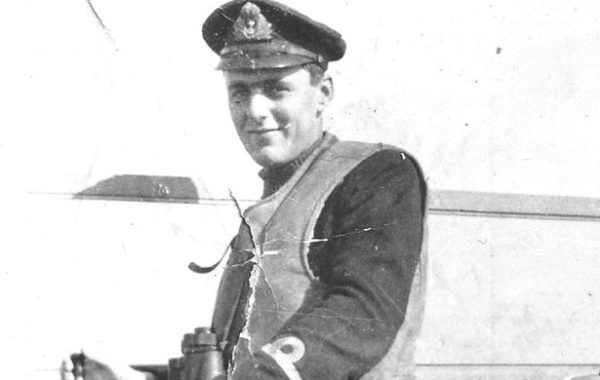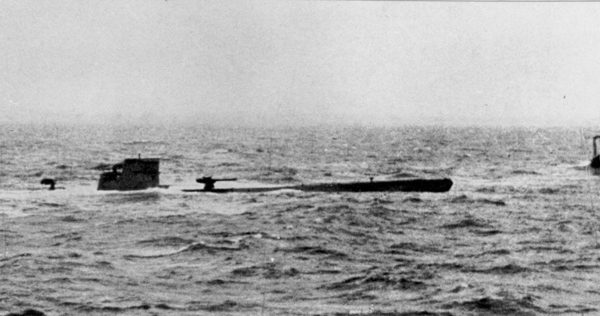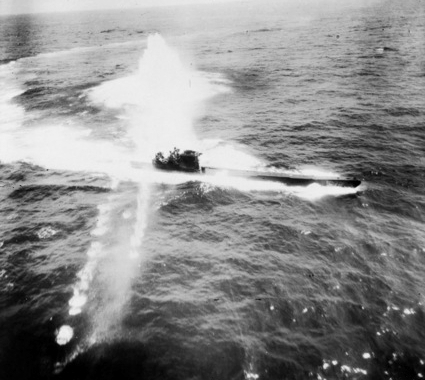When the United States entered World War II in December 1941, it did not take long for Hitler’s U-boats to bring the war to America’s shores. During the first eight months of 1942, U-boats sank more than 600 Allied ships off the East coast and in the Caribbean, before U.S. defenses stiffened. Partly as a consequence of this experience, when British Prime Minister Winston Churchill met with President Franklin Roosevelt in Casablanca in January, 1943, they agreed that war against the U-boats should be a top priority.
That same month, a change in command in Germany would mark the beginning of a long, slow decline in the Nazi submarine threat through the remainder of the war. Adolf Hitler promoted Karl Doenitz, the U-boat fleet commander, to Grand Admiral of the German Navy. Day-to-day command of the submarine fleet passed to Doenitz’s chief of staff, who lacked his boss’s strategic foresight and never gained the unquestioned loyalty of U-boat captains that Doenitz enjoyed.
Several developments began turning the tide of the naval war by mid-1943. The extended range of Allied aircraft meant that U-boats could no longer act with impunity in the mid-Atlantic. Airborne radar, which the Nazis did not think possible, gave Allied planes the opportunity to attack U-boats on the ocean’s surface at night. Improvements in high frequency direction-finding allowed the Allies to locate U-boats whenever they were in communications with their headquarters.
The Allied surface navies benefitted from advances in weaponry and improved tactics. The Hedgehog system fired depth charges in a circular pattern ahead of a suspected U-boat’s anticipated course. Certain charges detonated on contact, while others were time-fused so that even a near miss might explode and damage a U-boat enough to bring it to the surface.
New tactics created special convoy escort groups that began deploying in April of 1943. They consisted of up to ten anti-submarine warships operating in concert with an aircraft carrier and became known as “hunter-killer” groups. Once a U-boat was detected, using sonar, radio frequencies or aerial spotting, a number of the group’s warships would be dispatched to stay on top of the submarine until it had to come to the surface, where it was no match for the firepower of the ships that awaited it.
The hunters had become the hunted.
Following D-day and the invasion of France, the Allies lost 24 merchant ships from September through December of 1944. In that same period, Germany lost 55 U-boats.
From Sept. 3, 1939, to May 8, 1945, roughly 39,000 men took part in U-boat combat operations; 27,500 of those men never returned. U-boats accounted for about 2,700 merchant ships sunk during the war, more than one ship for every day of the war. But their success came at a high price: 87 percent of all U-boats that sailed on operational patrols were sunk or lost, and seven of every ten crew members died at sea.
German U-boat
Enigma’s Mysteries Revealed
Nearly two years after the start of World War II, the British Royal Navy for the first time put a boarding party onto a crippled German submarine. On May 9, 1942, 20-year-old sub-lieutenant David Balme led a party of nine sailors onto U-110, not knowing if the boat had been booby-trapped and half expecting scuttling charges to detonate at any moment.
Balme and his men had been sent across from H.M.S. Bulldog by her captain, Commander Joe Baker-Cresswell, with orders to gather up signal books and any other useful materials they might find (see blog post “Lemp’s Fatal Mistake, Aug. 30, 2018). Balme was the first man into the submarine, and when he was certain the boat had been abandoned, he called for the rest of the men to join him in the U-boat’s control room.
“The lights were still on and everything was lying about just as if one had arrived at someone’s house after breakfast, before they had had time to make beds, etc., coats were thrown around, bunks half made,” he later remembered. “There was complete silence in the U-boat except for the continual thud of our own depth charges [in pursuit of a second U-boat]…a most unpleasant and frightening noise.”
He told the men to ignore anything that was obviously casual reading material and to take whatever else appeared to be of interest. Speed was of the essence because U-110 was sinking and Balme was still concerned about explosive charges. Complicating matters was the fact that none of the men read German.
At one point, a sailor came out of the U-boat’s radio room and told Balme, “There’s something rather interesting I want to show you.” In the cramped radio room, Balme was shown a typewriter-like device screwed to the table. He could see that pressing one key on the machine caused a different letter to light up on a display. Balme told the sailor to unscrew it and send it up with the rest of the material being gathered. The young sub-lieutenant had no way of knowing that his party had just recovered the first working model of the German naval Enigma machine, a top-secret prize British Intelligence had coveted since the start of the war.
As the day wore on and the submarine remained afloat, Balme became less concerned about scuttling charges or the boat’s quick demise. At one point, Bulldog sent over sandwiches and a small boat to replace the one that had smashed itself on the U-110’s deck. He did worry, however, when Bulldog was called away on a U-boat sighting and a dense fog settled on the ocean.
“There was I, with my boarding party aboard U-110 in the middle of the Atlantic, alone with no ships in sight and with the wind and sea gradually increasing,” Balme recalled. Fortunately, Baker-Cresswell’s dead-reckoning navigation skills brought Bulldog back to the crippled submarine before nightfall, and the treasure trove of materials, including the Enigma machine and its codebooks, were transferred to the British destroyer.
By day’s end, Bulldog took U-110 under tow in hopes of delivering her to Iceland for careful inspection by British submarine experts. The next day, however, the U-boat sank en route. By then, the submarine’s capture and its trove of materials had been given a top-secret designation with the code name “Primrose.” Great effort went into limiting the number of people made aware of Primrose, and the capture was kept secret for several decades after the war.
U-110’s sinking may have been a blessing in disguise. Had the boat been towed to Iceland, it is entirely possible that local German spies would have relayed its capture to German authorities. German naval commanders would have assumed their encrypted communications could be compromised and they would have made changes to the Enigma machine and its codes much sooner than was actually the case. Even after the Germans made modifications in an effort to restore the naval Enigma’s integrity, insights gained by British intelligence from the materials taken from U-110 helped reduce code-breaking to a matter of hours or days instead or weeks.
At least one naval historian went so far as to characterize Operation Primrose on a scale commensurate with the outcomes of the Battle of Midway in the Pacific and the Battle of Stalingrad in Europe – not a bad day’s work for a Royal Navy convoy escort group and a junior naval officer barely out of his teens.
Lemp’s Fatal Mistake
The man who sank the unarmed British passenger ship Athenia on the first day of World War II, Kapitanleutnant Fritz-Julius Lemp, had managed to become a “U-boat Ace” in the 20 months of the war since his tragic mistake. Lemp had been credited with 22 ships sunk or damaged and awarded the Knights Cross, Germany’s highest award for valor. But in May of 1941 the brash, young U-boat commander’s luck was about to run out.
Two days after the Enigma code books for June were taken off the German trawler München (see blog post for Aug. 6. 2018), Lemp, now in command of U-110, attacked a westbound convoy off Greenland in the middle of the day. He fired a fan of four torpedoes at a horizon filled with Allied ships. Two shots struck home, adding two ships to Lemp’s tally. His third torpedo missed, and the fourth failed to launch from its tube. As Lemp waited at periscope depth to reset his forth torpedo for another shot, he was discovered by a British corvette that crippled U-110 with a depth charge attack.
Commander Joe Baker-Cresswell, the man in charge of the convoy escorts, was surprised to see U-110 pop to the surface in front of his flagship, H.M.S. Bulldog. He ordered his destroyer ahead at full speed, intent on ramming the U-boat, but thought better of it when he realized the Germans were abandoning ship. At almost that same instant, Kapitanleutnant Lemp was telling his radio operator not to worry about destroying the boat’s Enigma machine and code books, and to get off the ship immediately because it was sinking.
But U-110 did not sink, at least not immediately. Sensing a unique opportunity, Baker-Cresswell brought Bulldog to a stop just near U-boat He put David Balme, a 20-year-old sub-lieutenant, in charge of a boarding party and sent them off in small boat with instructions to gather up any signal books he could find on the submarine.
When they were nearly alongside the U-boat, their small boat was swept up by a large swell and smashed onto U-110’s deck. The men scrambled out onto the U-boat and climbed to the top of the conning tower, where Balme was surprised to find the entry hatch closed tight. Why close a hatch if the boat was intended to sink, he wondered? He opened the hatch and had to holster his revolver to climb down the ladder, feeling totally exposed if any Germans were still aboard.
“This was a nasty moment,” Balme later wrote, “one looked down below and wondered how many Germans were there. I went down the ladder to the lower conning tower where there was a similar closed hatch. On opening this hatch I found the control room deserted! Hatches leading forward and aft were open and all lighting on.”
He could hear air escaping somewhere in the U-boat, but there was no hint of chlorine, a deadly gas that could be produced by the boat’s batteries being submerged in seawater. For young Balme, the discoveries were just beginning, as we will see in our next blog.
When Warning Was Required
A little more than eight hours after England and Germany declared war on Sept. 3, 1939, a German submarine attacked and sank the British passenger ship Athenia. In the days and weeks that followed the sinking, British politicians, diplomats and newspaper editorials made much of the fact that the German attack came “without warning.” (Without Warning is the title of my forthcoming historical novel that tells the story of this little-known event.)
The phrase seems oddly quaint today, especially considering the terrible carnage suffered by civilian populations during World War 2 and many wars since, much of it delivered with little or no warning from the attackers. In 1939, however, the requirement for warships to follow certain international “prize rules” was widely understood to be a standard of civilized warfare.
For much of World War 1 Germany ignored the prize rules and waged unrestricted warfare against all enemy ships, including unarmed merchant vessels. Germany’s submarines, known as U-boats, were particularly effective instruments of unrestricted warfare because, unlike other ships, they could attack from underwater without revealing their presence. Read More





